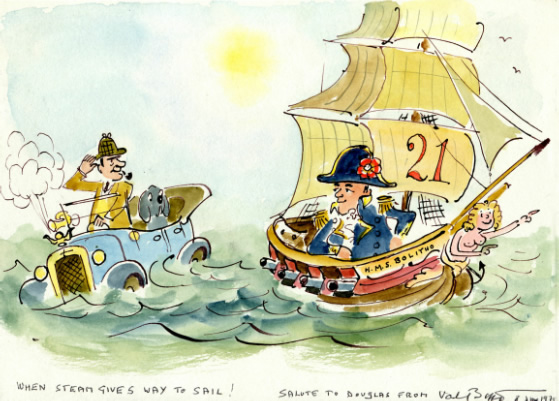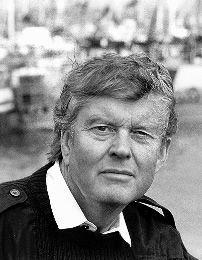The Artists

‘When steam gives way to sail!’ Salute to Douglas Reeman from Val Biro. The ‘21’ on the sail refers to the author's twenty-first year in the business. The cartoon was done in 1979.
THE WORK OF THREE British artists — Val Biro, Chris Mayger, and Geoffrey Huband — has illuminated the world created by Douglas Reeman in each of his novels about the sea. Douglas explains the role over the years of each artist:
Val Biro
‘Val Biro first came into it when he was asked to create the Bolitho logo, which was to be used on book jackets, bookmarks, newsletters and other advertising material. It became very well known. I actually saw him doing it. “I love those hats,” he said, drawing it. He also did endpaper maps and cross-sections of ships, and several years later he created the logo of a younger Bolitho (above right) for the midshipman series. I gave him all the info and told him the type of uniform, which had to be absolutely right for the period, and without epaulettes, Bolitho's age, that sort of thing, and he did it while I was watching, with, I think, a wide-nibbed pen. He was also an author in his own right and illustrated all his own books.
Chris Mayger
‘Chris Mayger began painting covers in the 70s, I think. Prior to that, we had been using old paintings on book jackets. I think Sloop of War was the last one, and we started running out of appropriate paintings. This is not to be confused with the recent splendid photographic jackets.
‘Mayger actually wrote to my English publishers and asked if he could do an illustration for a book jacket for me, they asked me if I was interested, and I said yes, give him a go. He sent pictures to me, I seem to recall. The jacket paintings were extremely good, and he started doing them for Reeman as well (he also started to do them for other authors, which was a little disconcerting) and he began to sell his paintings at the Royal Society of Marine Artists exhibitions, and became very well known, all because of Bolitho.
‘Temperamentally he was very difficult. I hardly ever had any personal contact with him.
Geoffrey Huband

Geoffrey Huband
‘Mayger died, and there was an interim period when jacket artists were being used by the publisher, not always to my satisfaction. Then, while Kim and I were travelling in Cornwall in the spring of 1985, she took me to Mousehole, a fishing village not far from Penzance, which she, a Canadian, had visited, and I, who had lived in Cornwall, had never been before.
‘We were walking up a steep street in the village and there in the window of an art gallery was the most perfect painting of a frigate and a revenue cutter speaking at dawn. Knowing what a stickler for accuracy I am, Kim asked me if it was good, technically, I mean. I said it was very, very good. We went in, and she bought it for me, and I liked it so much that I wrote to the artist and asked if he had ever considered doing jacket paintings. He replied that he had been reading my books for years, and so a working relationship and a firm friendship was established.
‘We work very closely together. I give Geoffrey date, time, place, the weather, all vital for a maritime artist, some incidents from the story, manuscript pages, type of ships involved, and a few ideas of my own, and he comes up with a beautiful pencil “rough” which is so good it could be framed, and then he does the painting.
‘They used to be watercolour but now he's developing his oil technique further, with magnificent results. We also confer on the phone a lot. As for the little painting, it still hangs in our bedroom, and we have other Huband originals around the house.
‘My American publisher, McBooks Press, is now using Geoffrey Huband’s paintings. Before that, Mayger’s jackets tended not to be used on US editions. I was very rarely asked to participate in discussions about American covers, although Walter Minton at Putnam, my first American publisher, did use an original photo I took of the monitor HMS Roberts, which was in Devonport waiting to be broken up, for the first cover of HMS Saracen.’
